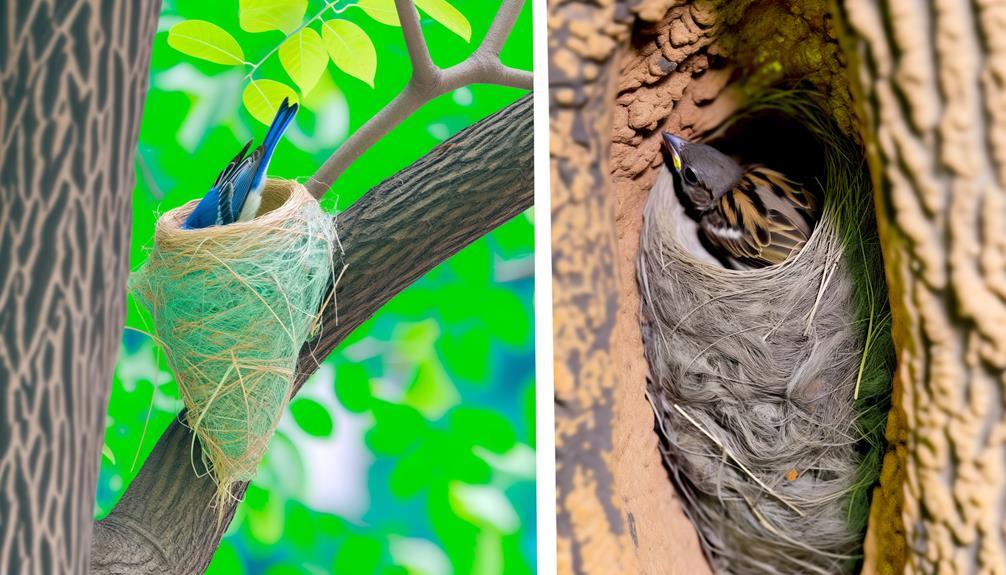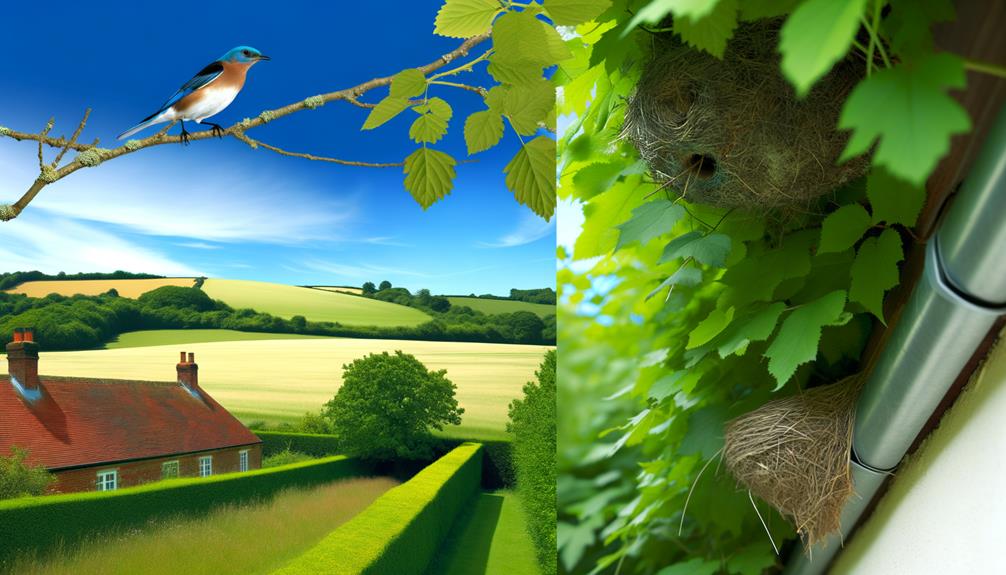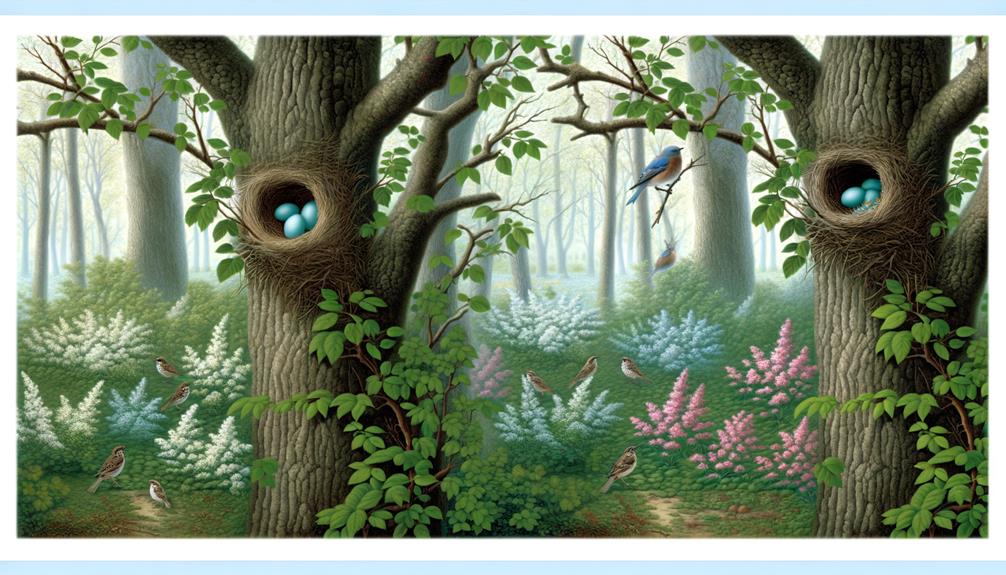Bluebird Nest vs Sparrow Nest: 10 Key Differences
You'll find bluebird and sparrow nests quite different. Bluebirds choose open fields and meadows, nesting in tree cavities or man-made boxes and using grasses, pine needles, and animal hair for cup-shaped nests.
Sparrows, however, adapt to urban settings, opting for building eaves or dense hedges. Their nests are round and enclosed, using twigs, paper, and feathers.
Bluebird habitats include open, grassy areas, while sparrows favor dense vegetation. Bluebirds' nesting season runs March to July with two broods per season; sparrows, from late winter through August, with multiple broods.
To discover more about their nesting behaviors and how to attract them, keep going.

Key Takeaways
- Bluebird nests are cup-shaped and open, while sparrow nests are round and dome-like for better protection.
- Bluebirds use natural materials like grasses and leaves, whereas sparrows incorporate urban debris like paper and feathers.
- Bluebirds prefer open fields and meadows with scattered trees, while sparrows favor urban areas and dense shrubbery.
- Bluebirds nest in tree cavities or man-made boxes, while sparrows nest in a variety of locations including building eaves and dense hedges.
- Bluebird nests provide easy access and ventilation, whereas sparrow nests maintain stable internal temperatures.
Nesting Locations

When comparing nesting locations, you'll find that bluebirds typically prefer open fields and meadows, while sparrows often choose urban areas or dense shrubbery. Bluebirds favor habitats that offer easy visibility and access to insects, creating a safer environment for raising their young. You'll notice they often select tree cavities or man-made nest boxes situated in these open spaces.
On the other hand, sparrows are more adaptable to human-altered landscapes. They nest in a variety of locations, including building eaves, dense hedges, and even within structures. Their preference for urbanized areas allows them to exploit various food sources and nesting sites.
Observing these choices can guide you in providing suitable habitats for each species, enhancing your role in bird conservation efforts.
Nest Construction Materials
Bluebirds primarily use grasses, pine needles, and soft leaves to construct their nests, while sparrows often incorporate twigs, paper, and other urban debris. You'll notice that bluebirds favor natural materials that blend seamlessly into their rural habitats. In contrast, sparrows adapt to urban environments by utilizing readily available man-made items. This difference highlights each species' unique approach to nest building.
Here's a comparison of their nest construction materials:
| Bluebird Materials | Sparrow Materials | Commonality |
|---|---|---|
| Grasses | Twigs | Natural fibers |
| Pine needles | Paper | Availability |
| Soft leaves | Urban debris | Adaptability |
| Animal hair | Feathers | Insulation |
Nest Shape and Structure

Although both species exhibit distinct preferences, you'll find that bluebird nests are typically cup-shaped, while sparrow nests tend to be more round and enclosed.
Bluebirds construct their nests with a neat, open cup structure, allowing for ample ventilation and easy access for the adults. This design supports best egg incubation and chick rearing.
In contrast, sparrows build more intricate, dome-like nests with a small entrance hole. This round shape provides extra protection against predators and environmental elements. The enclosed structure also helps maintain a stable internal temperature, necessary for egg development.
Preferred Habitats
Understanding the preferred habitats of bluebirds and sparrows is essential for fostering environments that cater to their nesting and breeding needs. Bluebirds thrive in open, grassy areas with scattered trees and shrubs, which provide ample foraging opportunities and nesting sites. They prefer habitats with minimal ground cover and plenty of perches.
In contrast, sparrows are highly adaptable and can nest in a variety of environments, from urban settings to rural farmlands. They favor dense vegetation, hedges, and structures that offer shelter and nesting materials.
Nesting Season

You'll observe that bluebirds typically commence their nesting season in early spring, often spanning from March to July, whereas sparrows may start in late winter and continue through August.
Bluebirds usually have two broods per season, meticulously constructing cup-shaped nests. In contrast, sparrows can produce multiple broods and frequently reuse their nests, exhibiting less stringent construction habits.
Timing and Duration
The nesting season for bluebirds typically begins in early spring, while sparrows often start nesting slightly later in the season. You'll observe distinct differences in timing and duration:
- Bluebirds: Nesting can start as early as March, with multiple broods until late summer.
- Sparrows: Usually begin in April or May, extending into mid-summer.
- Duration: Bluebird nests usually take 11-19 days for incubation and another 17-21 days for fledging.
- Sparrows: Incubation lasts about 10-14 days, with fledging occurring in 14-17 days.
Understanding these timelines helps you support each species effectively. Early preparation for bluebirds is essential, while sparrows require more ongoing attention as their nesting season progresses.
Observing these patterns guarantees you can offer timely and appropriate assistance.
Nesting Habits
While timing and duration are key factors, you'll also find notable differences in the nesting habits of bluebirds and sparrows during their respective seasons. Bluebirds prefer open areas with scattered trees and nest in cavities. They often reuse nesting sites. Sparrows, however, build nests in dense shrubs or trees, using grass and feathers.
| Aspect | Bluebird Nesting | Sparrow Nesting |
|---|---|---|
| Preferred Sites | Cavities, birdhouses | Dense shrubs, trees |
| Materials | Grass, pine needles | Grass, feathers, twigs |
| Reuse Frequency | Often reuse old nests | Rarely reuse old nests |
| Nest Height | Low to mid-height | Variable, often higher |
Understanding these habits helps you support each species' nesting success, tailoring birdhouse placements and materials to their specific needs.
Egg Characteristics
When examining egg characteristics, you'll notice that bluebird eggs are typically oval-shaped and pale blue.
In contrast, sparrow eggs are more variable in shape, often more rounded, with coloration ranging from white to gray or brown with speckled patterns.
These differences in egg shape and color serve as key identifiers between the two species.
Egg Shape Differences
Egg shape differences between bluebirds and sparrows present unique adaptations. Bluebird eggs typically exhibit a more elongated and oval form compared to the rounder, more spherical shape of sparrow eggs. Understanding these differences can help you identify and care for these birds' nests.
- Elongated Form: Bluebird eggs tend to have a more streamlined, oval shape, which can aid in fitting within narrow nesting cavities.
- Spherical Shape: Sparrow eggs are generally rounder, providing a compact form that fits well in densely packed nests.
- Adaptation: The different shapes reflect each species' nesting environment and reproductive strategies.
- Identification: Recognizing these shapes can enhance your ability to monitor and protect these birds more effectively.
Color and Patterns
Bluebird eggs often display a vibrant blue hue, whereas sparrow eggs typically exhibit more muted tones with speckled patterns. When observing bluebird eggs, you'll notice their uniform, striking blue coloration, which can vary slightly in intensity. This distinct hue serves as a clear identifier in the field.
On the other hand, sparrow eggs are usually a pale, off-white or grayish tone, adorned with brown or black speckles. These speckled patterns provide camouflage, blending seamlessly with their nest surroundings.
As you study these egg characteristics, remember that these differences not only aid in species identification but also reflect evolutionary adaptations. By recognizing these patterns, you can better appreciate the unique strategies each bird employs to protect and nurture their offspring.
Incubation Period

During the incubation period, you'll notice that bluebird and sparrow nests exhibit distinct behaviors and timelines. Bluebirds typically incubate their eggs for about 12-14 days, while sparrows require around 10-14 days. Observing closely, you'll see:
- Bluebird females primarily handle incubation, leaving the nest only briefly.
- Sparrow females also incubate, but males occasionally assist by feeding them.
- Egg turning happens frequently in both species, ensuring even temperature distribution.
- Temperature regulation is crucial; bluebird nests are often insulated better than sparrow nests.
Understanding these nuances helps you appreciate the delicate balance each species maintains during this critical period. Your keen observations and willingness to serve can make a significant difference in supporting these avian families.
Fledgling Care
You'll notice distinct differences in fledgling care between bluebirds and sparrows, with each species employing unique strategies to guarantee the survival of their young. Bluebird parents feed their fledglings continuously, ensuring they receive a protein-rich diet essential for growth. In contrast, sparrows balance feeding with teaching survival skills like foraging. Monitoring these species reveals interesting patterns in parental roles and duration of care.
| Aspect | Bluebirds | Sparrows |
|---|---|---|
| Feeding Frequency | Continuous | Balanced with skill teaching |
| Diet | Protein-rich insects | Mixed diet |
| Parental Roles | Both parents equally involved | Primarily female-led |
| Duration of Care | 17-21 days | 14-16 days |
Understanding these differences helps you support conservation efforts, ensuring these birds thrive in their natural habitats.
Common Nesting Challenges

Nesting challenges for both bluebirds and sparrows often include predation, competition for nesting sites, and environmental factors such as weather and habitat destruction. You need to understand these obstacles to effectively support these birds.
- Predation: Predators like snakes, raccoons, and cats threaten eggs and fledglings.
- Competition: House sparrows and starlings can aggressively compete for nesting sites, sometimes evicting bluebirds.
- Weather: Severe storms or prolonged cold spells can damage nests and jeopardize young birds.
- Habitat Destruction: Urbanization and deforestation reduce available nesting sites, forcing birds into suboptimal locations.
Attracting Bluebirds and Sparrows
To attract bluebirds and sparrows, you'll need to think about their ideal nesting habitats, specific food preferences, and the distinct features of their nest boxes. Bluebirds prefer open fields and meadows, feeding on insects, while sparrows are more adaptable, thriving in urban and rural environments with seeds and grains.
Make sure that your nest boxes have appropriate entrance hole sizes and placements to suit each species' requirements.
Ideal Nesting Habitats
To attract bluebirds and sparrows, it's crucial to grasp their preferred nesting habitats and the specific environmental factors that cater to their needs. Bluebirds thrive in open fields with scattered trees, while sparrows prefer urban or suburban settings with dense shrubbery.
To establish an ideal nesting habitat, consider the following:
- Location: Position nest boxes for bluebirds in open areas; sparrows' nests work well in gardens or near buildings.
- Height: Install bluebird boxes 4-6 feet above ground; sparrows prefer nests at varying heights, often higher.
- Material: Utilize untreated wood for nest boxes to ensure safety and durability.
- Entrances: Bluebirds require 1.5-inch entry holes; sparrows can use slightly larger or smaller entrances.
These steps will aid in creating a suitable environment for both species.
Food Preferences
Understanding the dietary needs of bluebirds and sparrows is crucial in attracting these birds to your garden. Bluebirds primarily consume insects like beetles, caterpillars, and grasshoppers, which provide high protein levels crucial for their energy demands. Supplement their diet with mealworms, especially during breeding season.
Meanwhile, sparrows are more granivorous and prefer seeds like millet, sunflower, and cracked corn. They also occasionally eat insects and fruit.
To attract both species, offer a variety of food sources. Place mealworms in a shallow dish for bluebirds and scatter seeds on the ground or in feeders for sparrows. Make sure food is fresh and clean, helping to maintain the birds' health and encouraging their frequent visits to your garden.
Nest Box Features
When choosing or constructing nest boxes for bluebirds and sparrows, pay attention to specific measurements, entrance hole size, and placement to cater to each species' nesting preferences.
Bluebirds thrive in boxes with a 1.5-inch entrance hole, while sparrows prefer a slightly smaller 1.25-inch hole. Optimal placement varies; bluebirds favor open fields, whereas sparrows are less particular and adapt to various environments.
Key features include:
- Measurements: Bluebird boxes should be 5×5 inches at the base; sparrow boxes can be more adaptable.
- Entrance Hole: Select the appropriate diameter to attract the desired species.
- Position Height: Mount bluebird boxes 4-6 feet high; sparrow boxes can be positioned lower.
- Ventilation and Drainage: Both species require sufficient airflow and water drainage to ensure nest dryness and comfort.
Conclusion
In comparing bluebird and sparrow nests, you'll notice striking differences. Bluebirds prefer open fields and construct neat, cup-shaped nests using grasses, while sparrows favor urban areas, crafting messy nests from varied materials.
Bluebirds have a precise incubation period and meticulous fledgling care, contrasting with the sparrow's adaptable, yet less structured approach.
Understanding these distinctions not only enriches your knowledge of avian behaviors but also helps you better attract these fascinating birds to your environment.






